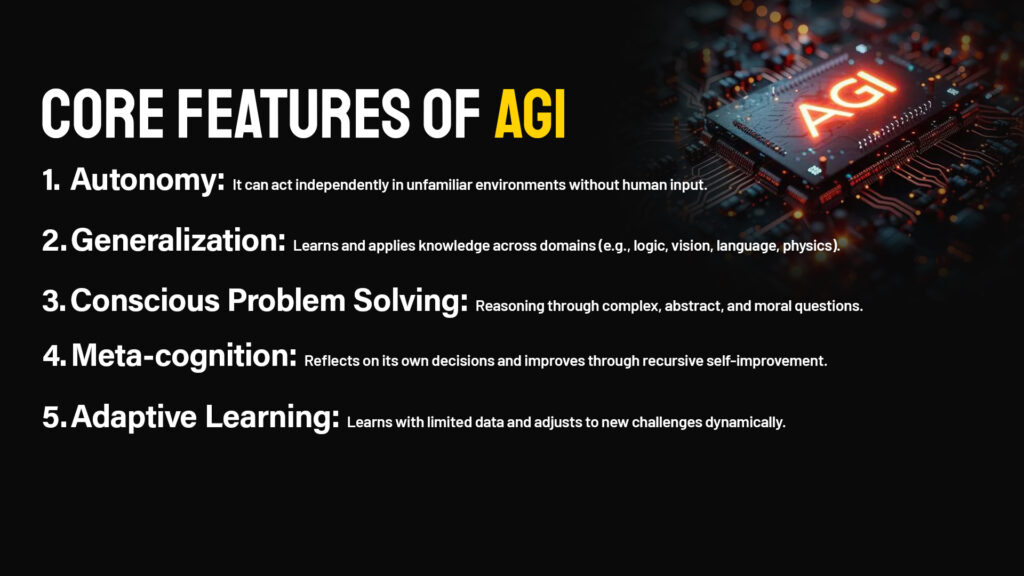Why in News?
The global race for Artificial General Intelligence (AGI) has intensified with tech giants like OpenAI, Google DeepMind, and Anthropic announcing breakthroughs in multimodal reasoning and emergent capabilities. The recent AI Safety Summits, including the Bletchley Declaration, underscore both the promise and peril of AGI. With India’s IndiaAI Mission also focusing on foundational models, AGI is no longer a speculative frontier—it is a near horizon.
What is Artificial General Intelligence (AGI)?
AGI refers to a form of artificial intelligence that possesses the ability to understand, learn, and apply knowledge across a broad range of tasks—just like a human being. Unlike narrow AI, which is domain-specific (e.g., a chess engine or speech-to-text model), AGI aims for cognitive flexibility, reasoning, and even self-awareness.

It is also called Strong AI, Full AI, or General Intelligence, and is characterized by the Turing Test equivalence—an AI indistinguishable from human intellect.
Core Features of AGI
- Autonomy: It can act independently in unfamiliar environments without human input.
- Generalization: Learns and applies knowledge across domains (e.g., logic, vision, language, physics).
- Conscious Problem Solving: Reasoning through complex, abstract, and moral questions.
- Meta-cognition: Reflects on its own decisions and improves through recursive self-improvement.
- Adaptive Learning: Learns with limited data and adjusts to new challenges dynamically.

Current Progress and Pathways
While true AGI has not yet been achieved, researchers are exploring multiple pathways:
- Cognitive Architectures: Projects like SOAR and OpenCog mimic human cognition.
- Neurosymbolic AI: Combines symbolic logic with deep learning to simulate reasoning.
- Scaling Hypothesis: Argues that increasing model size (like GPT-4, Gemini) will eventually lead to general intelligence.
- Whole Brain Emulation (WBE): A controversial approach that seeks to replicate neural structures digitally.
Notable efforts include:
- OpenAI’s Q* model (allegedly showing reasoning capacity).
- Google DeepMind’s Gemini and Anthropic’s Claude for safety-aligned reasoning.
- Elon Musk’s xAI focusing on alignment through philosophical modeling.
Economic and Strategic Stakes
- AGI could unlock multi-trillion-dollar productivity gains via automation, scientific discovery, and medical diagnostics.
- Geopolitical influence is shifting toward countries with advanced AI ecosystems.
- AGI arms race is now a feature of techno-nationalism, especially between the US, China, and the EU.
- India’s IndiaAI Mission emphasizes explainability, transparency, and foundational AI research—positioning India as an ethical power in AI governance.
Ethical and Existential Concerns
- Control Problem: Can humans control an intelligence more capable than themselves?
- Value Alignment: Will AGI understand and share human values?
- Employment Disruption: Risk of displacement across knowledge-intensive sectors.
- Bias and Ethics: If trained on biased data, AGI may perpetuate systemic injustice.
- Doomsday Scenario: Pioneers like Elon Musk, Stuart Russell, and Nick Bostrom warn of extinction-level risks if AGI misaligns with human interests.
AGI is increasingly viewed as a “dual-use technology”—potentially beneficial, yet fraught with risk.
Regulation, Alignment and Global Coordination
- The Bletchley Declaration (2023) initiated multilateral efforts to manage AGI safety.
- The EU AI Act offers a template for AGI risk classification and governance.
- India’s approach favors open-source, low-resource AI with built-in ethical guardrails.
- Global efforts now include AI governance summits, AI safety institutes, and AGI red-teaming coalitions.
Way Forward for India
- Foundational Research: Promote indigenous AGI architecture under IndiaAI R&D clusters.
- Sanskritic and Philosophical Integration: Leverage India’s dharmic traditions, non-dualist metaphysics, and ethical pluralism for value alignment.
- Strategic Autonomy: Develop compute sovereignty and indigenous LLMs.
- AI Safety Sandbox: Create a national task force on AGI alignment and existential safety.
A Turning Point in Human Evolution
“With Artificial General Intelligence, we are summoning the demon.” — Elon Musk
AGI represents a new ontological category—not just a tool, but potentially a synthetic species. Whether it becomes the greatest boon or the gravest threat to civilization depends on how we design, align, and govern it today. For India, the path forward lies in balancing ambition with ethics, innovation with regulation, and power with prudence.

